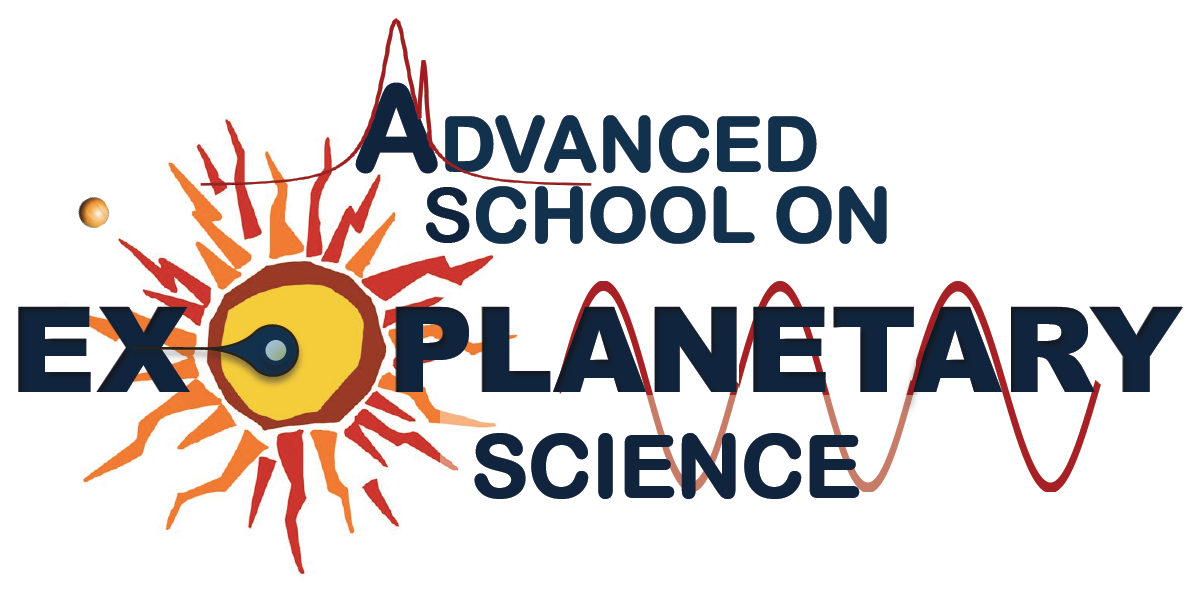
Hello, welcome to my home page.
I am an Associate Professor working at the Department of Physics of the University of Rome Tor Vergata. I am also affiliated with the Max Planck Institute for Astronomy in Heidelberg (MPIA) and the INAF Astrophysical Observatory of Turin (OATo).
My current research activity is mainly focused on the detection of exoplanets and their physical, atmospherical and orbital characterization, including the characterization of their parent stars (chemical composition, atmospheric and physical parameters) and their environment, utilizing both ground-based and space-borne observatories and instrumentations across a wide range of wavelengths. In particular, I have been working in the Exoplanet field for more than 15 years and, over this time,
- I have been the discoverer and co-discoverer of more than 100 planets with the Transit technique and roughly 20 planets with the Radial-Velocity (including Teegarden’s Star b, which has the higher Earth Similarity Index) and Microlensing techniques;
- I have contributed to characterising the physical, orbital and atmospherical properties of more than 450 planetary systems and validated more than 100 planets, not to mention binary systems and brown dwarfs;
- I had a primary role in HATSouth, one of the most important and successful ground-based surveys for transiting exoplanets; I also collaborated with other ground-based-survey teams (WASP, KELT, QES) and confirmed several exoplanets detected by the Kepler and TESS space telescopes;
- I participated to several observational programs to confirm the planetary nature of Kepler and K2 candidates via radial-velocity measurements, and I am now working on TESS data;
- I pioneered different observational techniques and strategies to obtain better measurements of transiting-exoplanet parameters, like telescope defocussing, transmission photometry, the use of multi-band cameras in the observations of planetary transits and the two-site observational strategy;
- I was PI and Co-PI of over fifty observational programs with ESO telescopes (VLT, ESO-3.6m, ESO-2.2m, DK 1.5m) and others (LBT, TNG, NOT, INT, CAHA-2.2m, CAHA-1.2m, Asiago 1.8m, Cassini 1.5m) for the monitoring and follow-up observations of exoplanetary systems;
- I was member of CARMENES, which carried out a survey of 300 late-type main-sequence stars with the goal of detecting low-mass planets in their habitable zones;
- I had a primary role in the EDEN survey, which provided the most sensitive volume-complete photometric monitoring of late-M dwarf stars to date and upper limits on the short-period planet population around TRAPPIST-1-like host stars;
- I was member of the Transiting Exoplanet Community Early Release Science program of the James Webb Space Telescope.
I am currently involved in several collaborations. In particular,
- I am PI of the MIUR-PRIN project No. 2022J4H55R “Detection of Earth-like ExoPlanets”;
- I am member of the PLATO Mission Consortium (Working Package 115200);
- I am member of the NASA Great Observatory Maturation Program (GOMAP) Habitable Worlds Observatory (START Living Worlds Working Group);
- I am member of the scientific advisory committee del Vatican Advanced Technology Telescope (VATT);
- I am member of the GAPS Science Team;
- I am member of the MiNDSTEp collaboration;
- I am member of the Hot-Neptune Initiative.
Within the GAPS project, we discovered TOI-1853b, which is the most dense Neptune-sized planet in the known Galaxy thanks to TESS data and precise radial-velocity measurements with HARPS-N at the TNG (Nature 622, 255, 2023).

I was a member of the JWST (James Webb Space Telescope) Transiting Exoplanet Community Early Release Science program, whose goal was to understand the limitations and capabilities of the JWST instruments and provide the scientific community with the technical skills to analyze JWST data, in particular those concerning the study of the atmospheres of transiting exoplanets. The aim was not only to demonstrate JWST's ability to obtain precise measurements of the chemical composition of the atmospheres of transiting planets but also to test the various instrumental modalities, which are currently used to study a wide variety of exoplanets, from the hot and giant ones up to the more temperate and terrestrial ones. A little over a month after the first data collected by the James Webb Space Telescope, the Transiting Exoplanet Early Release Science Team unequivocally detected carbon dioxide in the atmosphere of the exoplanet WASP-39b. In 2023, we achieved another first: an extremely detailed molecular and chemical portrait of the skies of the exoplanet WASP-39b. Among the unprecedented revelations, there is the first detection in an exoplanetary atmosphere of sulphur dioxide, a molecule produced by chemical reactions triggered by highly energetic radiation from the planet's parent star. Other atmospheric constituents detected by the JWST include sodium, potassium and water vapour, confirming previous observations from space and ground-based telescopes, as well as finding additional traces of water, at longer wavelengths, that had never been seen Before. The JWST also saw carbon monoxide and carbon dioxide, the latter at higher resolution, providing double the data reported by its previous observations. These results have been described in a series of papers published in Nature (Volume 614 Issue 7949, Collection).

The presence of sulfur dioxide in the atmosphere of WASP-39b was also confirmed by our detection of this molecule at 7.7 and 8.5 micron in the transmission spectrum of WASP-39b measured by the JWST Mid-Infrared Instrument (MIRI) Low Resolution Spectrometer (Nature 626, 979, 2024).
We also obtained a thermal emission spectrum of the ultra-hot Jupiter WASP-18b measured from 0.85 to 2.85 micron with JWST’s NIRISS instrument (Nature 620, 292, 2023) and a phase-resolved thermal emission spectrum of the hot Jupiter WASP-43b measured from 5 to 12 micron with the JWST’s MIRI Instrument (Nature Astronomy 8, 879, 2024). This spectrum reveals a large day–night temperature contrast and evidence for water absorption at all orbital phases.
We also reported the detection of inhomogeneous terminators on the exoplanet WASP-39b, which allowed us to retrieve its morning and evening transmission spectra in the near-infrared using the JWST (Nature 632, 1017, 2024).
Finally, we presented a combined analysis of JWST transmission spectroscopy across four different instrumental modes spanning 0.5–5.2 micron using Early Release Science observations of the Saturn-mass exoplanet WASP-39 b. Our uniform analysis constrains the orbital and stellar parameters within sub-percentage precision, including matching the precision obtained by the most precise asteroseismology measurements of stellar density to date, and it further confirms the presence of Na, K, H2O, CO, CO2 and SO2 as atmospheric absorbers (Nature Astronomy 8, 1008, 2024).
I am leading a long-term observational program to accurately measure the characteristics of known exoplanet systems hosting close-in transiting giant planets. Our study is based on high-quality photometric follow-up observations of transit events with an array of medium-class telescopes, which are located in both the northern and the southern hemispheres. High photometric precision is achieved through the telescope-defocussing technique. The data are then reduced and analyzed homogeneously for estimating the orbital and physical parameters of both the planets and their parent stars. We also make use of multi-band imaging cameras for probing planetary atmospheres via the transmission-photometry technique. In some cases, we adopt a two-site observational strategy for collecting simultaneous light curves of individual transits, which is the only reliable method for truly distinguishing a real astrophysical signal from systematic noise.
I am the main organizer of the Advanced School on Exoplanetary Science, whose first four editions took place in Vietri sul Mare (Italy) in May 2015, 2017, 2019 (ASES3) and 2023 (ASES4). The next edition will be in May 2025 (ASES5).
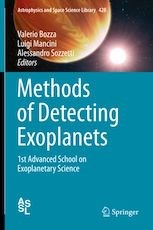 Lecture Notes of ASES1: Methods of Detecting Exoplanets
Lecture Notes of ASES1: Methods of Detecting Exoplanets
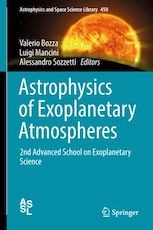 Lecture Notes of ASES2: Astrophysics of Exoplanetary Atmospheres
Lecture Notes of ASES2: Astrophysics of Exoplanetary Atmospheres
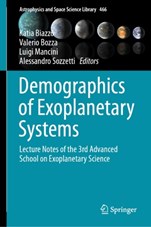 Lecture Notes of ASES3: Demographics of Exoplanetary Systems
Lecture Notes of ASES3: Demographics of Exoplanetary Systems
I am referee of several peer-reviewed journals, like Science, The Astrophysical Journal, The Astronomical Journal, Astronomy & Astrophysics, Monthly Notices of the Royal Astronomical Society, New Astronomy, Astronomy and Computing, General Relativity and Gravitation.
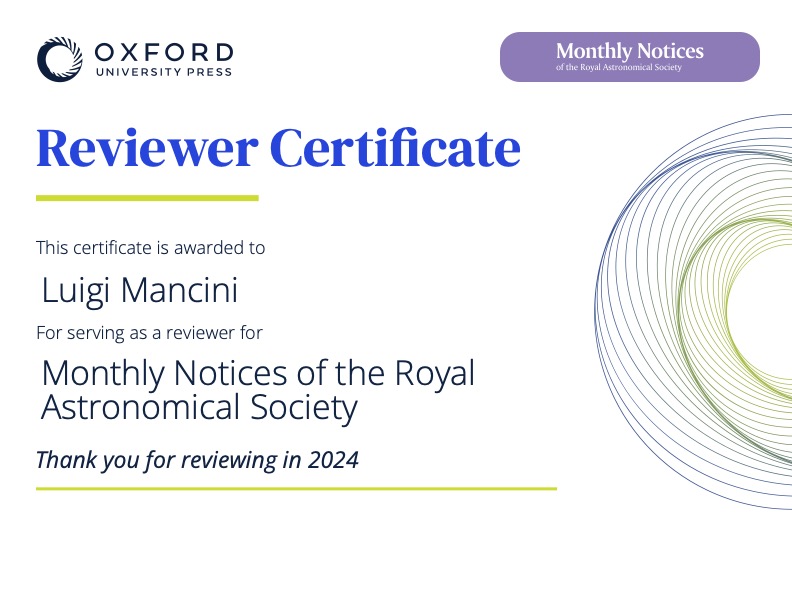
I currently serve as a reviewer on the "Exoplanet Atmospheres and Habitability Discussion panel" for the peer review process of JWST Cycle 5 proposals.
I am currently member of the "ESO Observing Programme Committee" for the peer review process of ESO P117 and P118 proposals (Category C).
I am on the Register of Experts who will act as External Reviewers for the Italian 2020-2024 VQR.
- Total number of papers published in peer-reviewed journals: 280
- Number of books published as an editor: 3
- h index : 57 (source: Astrophysics Data System – October 2025)
- h index : 68 (source: Google Scholar – October 2025)
The complete list of my publications is powered by the Astrophysics Data System
- Refereed - Papers in peer-reviewed journals
- non-Refereed - Papers under review, proceedings, on-line data
- All
- Statistics
Selected list of my publications in high impact Scientific Journals
- Inhomogeneous terminators on the exoplanet WASP-39 b
- N. Espinoza, M. E. Steinrueck, J. Kirk, et al., Nature 632, 1017 (2024) -- Link
- A benchmark JWST near-infrared spectrum for the exoplanet WASP-39 b
- A. Carter, E. M. May, N. Espinoza, et al., Nature Astronomy 8, 1008 (2024) -- Link
- Nightside clouds and disequilibrium chemistry on the hot Jupiter WASP-43b
- T. J. Bell, N. Crouzet, P. E. Cubillos, et al., Nature Astronomy 8, 879 (2024) -- Link
- Sulfur dioxide in the mid-infrared transmission spectrum of WASP-39b
- D. Powell, A. D. Feinstein, E. K. H. Lee, et al., Nature 626, 979 (2024) -- Link
- A super-massive Neptune-sized planet
- L. Naponiello, L. Mancini, A. Sozzetti, et al., Nature 622, 255 (2023) -- Link
- A broadband thermal emission spectrum of the ultra-hot Jupiter WASP-18b
- L.-P. Coulombe, B. Benneke, R. Challener, et al., Nature 620, 292 (2023) -- Link
- Early Release Science of the exoplanet WASP-39b with JWST NIRISS
- A. D. Feinstein, M. Radica, L. Welbanks, et al., Nature 614, 670 (2023) -- Link
- Early Release Science of the exoplanet WASP-39b with JWST NIRSpec G395H
- L. Alderson, H. R. Wakeford, M. K. Alam, et al., Nature 614, 664 (2023) -- Link
- Early Release Science of the exoplanet WASP-39b with JWST NIRSpec PRISM
- Z. Rustamkulov, D. K. Sing, S. Mukherjee, et al., Nature 614, 659 (2023) -- Link
- Early Release Science of the exoplanet WASP-39b with JWST NIRCam
- E.-M. Ahrer, K. B. Stevenson, M. Mansfield, et al., Nature 614, 653 (2023) -- Link
- Identification of carbon dioxide in an exoplanet atmosphere
- JWST Transiting Exoplanet Community Early Release Science Team, Nature 614, 649 (2023) -- Link
- A giant exoplanet orbiting a very-low-mass star challenges planet formation models
- J. C. Morales, A. J. Mustill, I Ribas, et al., Science 365, 1441 (2019) -- Link
Selected list of my publications in high impact factor Astrophysical Journals
- The Hot Neptune Initiative (HONEI) II. TOI-5795 b: A hot super-Neptune orbiting a metal-poor star
- F. Manni, L. Naponiello, L. Mancini, et al., Astronomy & Astrophysics 701, A230 (2025) -- Link
- An inner eccentric sub-Neptune and an outer sub-Neptune-mass candidate around BD+00 444
- L. Naponiello, A. S. Bonomo, L. Mancini, et al., Astronomy & Astrophysics 693, A7 (2025) -- Link
- Star-spot activity, orbital obliquity, transmission spectrum, physical properties, and transit time variations of the HATS-2 planetary system
- F. Biagiotti, L. Mancini, L., J. Southworth, et al., Astronomy & Astrophysics 685, A131 (2024) -- Link
- A puffy and warm Neptune-sized planet and an outer Neptune-mass candidate orbiting the solar-type star TOI-1422
- L. Naponiello, L. Mancini, M. Damasso, et al., Astronomy & Astrophysics 667, A8 (2022) -- Link
- Measurement of the Rossiter-McLaughlin effect and revising the physical and orbital parameters of the HAT-P-15, HAT-P-17, HAT-P-21, HAT-P-26, HAT-P-29 eccentric planetary systems
- L. Mancini, M. Esposito, E. Covino, et al., Astronomy & Astrophysics 664, A162 (2022) -- Link
- The ultra-hot-Jupiter KELT-16 b: dynamical evolution and atmospheric properties
- L. Mancini, J. Southworth, L. Naponiello, et al., Monthly Notices of the Royal Astronomical Society 509, 1447 (2022) -- Link
- An Isolated Stellar-mass Black Hole Detected through Astrometric Microlensing
- K. C. Sahu, J. Anderson, S. Casertano, et al., The Astrophysical Journal 933, 83 (2022) -- Link
- The highly inflated giant planet WASP-174b
- L. Mancini, P. Sarkis, Th. Henning, et al., Astronomy & Astrophysics 633, A30 (2020) -- Link
- Two temperate Earth-mass planet candidates around Teegarden's Star
- M. Zechmeister, S. Dreizler, I. Ribas, et al., Astronomy & Astrophysics 627, A49 (2019) -- Link
- Physical properties and transmission spectrum of the WASP-74 planetary system from multiband photometry
- L. Mancini, J. Southworth, P. Mollière, et al., Monthly Notices of the Royal Astronomical Society 485, 5168 (2019) -- Link
- Measurement of the Rossiter-McLaughlin effect of transiting planetary systems HAT-P-3, HAT-P-12, HAT-P-22, WASP-39, and WASP-60
- L. Mancini, M. Esposito, E. Covino, et al., Astronomy & Astrophysics 613, A41 (2018) -- Link
- HATS-50b through HATS-53b: Four Transiting Hot Jupiters Orbiting G-type Stars Discovered by the HATSouth Survey
- Th. Henning, L. Mancini, P. Sarkis, et al., The Astronomical Journal 155, 79 (2018) -- Link
- Detection of the Atmosphere of the 1.6 M⊕ Exoplanet GJ 1132 b
- J. Southworth, L. Mancini, N. Madhusudhan, et al., The Astronomical Journal 153, 191 (2017) -- Link
- Orbital alignment and star-spot properties in the WASP-52 planetary system
- L. Mancini, J. Southworth, G. Raia, et al., Monthly Notices of the Royal Astronomical Society, Volume 465, 843 (2017) -- Link
- An optical transmission spectrum of the transiting hot Jupiter in the metal-poor WASP-98 planetary system
- L. Mancini, M. Giordano, P. Mollière, et al., Monthly Notices of the Royal Astronomical Society, Volume 461, 1053 (2016) -- Link
- 197 Candidates and 104 Validated Planets in K2’s First Five Fields
- I. J. M. Crossfield, D. R. Ciardi, E. A. Petigura, et al., The Astrophysical Journal Supplement Series 226, 7 (2016) -- Link
- An optical transmission spectrum of the giant planet WASP-36 b
- L. Mancini, J. Kemmer, J. Southworth, et al., Monthly Notices of the Royal Astronomical Society, Volume 459, 1393 (2016) -- Link
- Kepler-539: A young extrasolar system with two giant planets on wide orbits and in gravitational interaction
- L. Mancini, J. Lillo-Box, J. Southworth, et al., Astronomy & Astrophysics 590, A112 (2016) -- Link
- Rotation periods and astrometric motions of the Luhman 16AB brown dwarfs by high-resolution lucky-imaging monitoring
- L. Mancini, P. Giacobbe, S. P. Littlefair, et al., Astronomy & Astrophysics 584, A104 (2015) -- Link
- HATS-13b and HATS-14b: two transiting hot Jupiters from the HATSouth survey
- L. Mancini, J. D. Hartman, K. Penev, et al., Astronomy & Astrophysics 580, A63 (2015) -- Link
- Observations of the Rossiter-McLaughlin effect and characterisation of the transiting planetary systems HAT-P-36 and WASP-11/HAT-P-10
- L. Mancini, M. Esposito, E. Covino, et al., Astronomy & Astrophysics 579, A136 (2015) -- Link
- Physical properties, star-spot activity, orbital obliquity and transmission spectrum of the Qatar-2 planetary system from multicolour photometry
- L. Mancini, J. Southworth, S. Ciceri, et al., Monthly Notices of the Royal Astronomical Society, Volume 443, 2391 (2014) -- Link
- Physical properties of the WASP-67 planetary system from multi-colour photometry
- L. Mancini, J. Southworth, S. Ciceri, et al., Astronomy & Astrophysics 568, A127 (2014) -- Link
- Physical properties and transmission spectrum of the WASP-80 planetary system from multi-colour photometry
- L. Mancini, J. Southworth, S. Ciceri, et al., Astronomy & Astrophysics 562, A126 (2014) -- Link
- Physical properties, transmission and emission spectra of the WASP-19 planetary system from multi-colour photometry
- L. Mancini, S. Ciceri, G. Chen, et al., Monthly Notices of the Royal Astronomical Society, Volume 436, 2 (2013) -- Link
- Physical properties of the WASP-44 planetary system from simultaneous multi-colour photometry
- L. Mancini, N. Nikolov, J. Southworth, et al., Monthly Notices of the Royal Astronomical Society, Volume 430, 2932 (2013) -- Link
- A lower radius and mass for the transiting extrasolar planet HAT-P-8 b
- L. Mancini, J. Southworth, S. Ciceri, et al., Astronomy & Astrophysics 551, A11 (2013) -- Link
- Observing Gravitational Lensing Effects by Sgr A* with GRAVITY
- V. Bozza & L. Mancini, The Astrophysical Journal 753, 56 (2012) -- Link
- The scaling relation between the mass of supermassive black holes and the kinetic energy of random motions of the host galaxies
- L. Mancini & A. Feoli, Astronomy & Astrophysics 537, A48 (2012) -- Link
- Microlensing towards the Large Magellanic Cloud: self-lensing for OGLE-II and OGLE-III
- S. Calchi Novati & L. Mancini, Monthly Notices of the Royal Astronomical Society, Volume 416, 1292 (2011) -- Link
- A Hertzsprung-Russell-like Diagram for Galaxies: The M • Versus M Gσ2 Relation
- A. Feoli & L. Mancini, The Astrophysical Journal 703, 1502 (2009) -- Link
- Gravitational Lensing of Stars Orbiting the Massive Black Hole in the Galactic Center
- V. Bozza & L. Mancini, The Astrophysical Journal 696, 701 (2009) -- Link
- Microlensing towards the LMC revisited by adopting a non-Gaussian velocity distribution for the sources
- L. Mancini, Astronomy & Astrophysics 496, 465 (2009) -- Link
- Gravitational Lensing of Stars in the Central Arcsecond of Our Galaxy
- V. Bozza & L. Mancini, The Astrophysical Journal 627, 790 (2005) -- Link
- LMC self-lensing from a new perspective
- L. Mancini & S. Calchi Novati, Ph. Jetzer, G. Scarpetta, Astronomy & Astrophysics 427, 61 (2004) -- Link
- Gravitational Lensing by Black Holes: A Comprehensive Treatment and the Case of the Star S2
- V. Bozza & L. Mancini, The Astrophysical Journal 611, 1045 (2004) -- Link
- Time Delay in Black Hole Gravitational Lensing as a Distance Estimator
- V. Bozza & L. Mancini, General Relativity and Gravitation 36, 435 (2004) -- Link
- Microlensing of strongly interacting binary systems
- V. Bozza & L. Mancini, Astronomy & Astrophysics 394, L47 (2002) -- Link
- Microlensing towards the Large Magellanic Cloud
- Ph. Jetzer, L. Mancini, G. Scarpetta, Astronomy & Astrophysics 393, 129 (2002) -- Link
- Microlensing by compact objects associated with gas clouds
- V. Bozza, Ph. Jetzer, L. Mancini, G. Scarpetta, Astronomy & Astrophysics 382, 6 (2002) -- Link
Teaching in the Physics Department
| ID | Course Name | Semester | Length | CFU |
|---|---|---|---|---|
| Astrophysical Techniques | Second | 14 Weeks | 8 | |
| Exoplanets | First | 14 Weeks | 6 |
